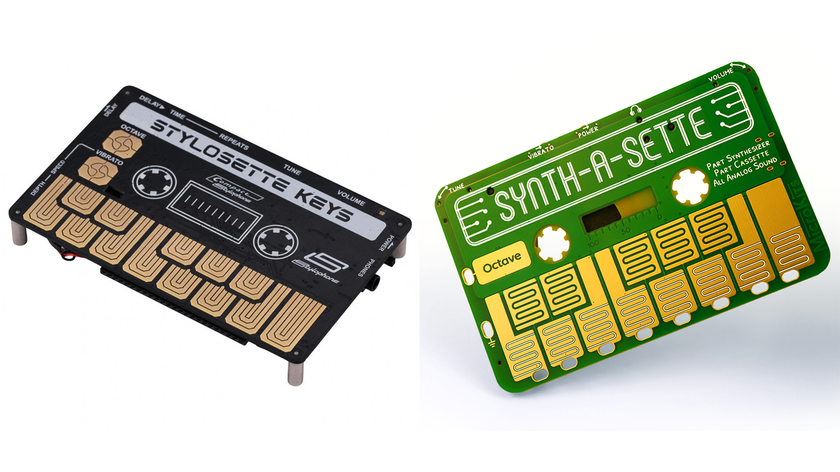Teengirl Fantasy on their evocative sound and hands-on creative approach
Logan Takahashi and Nick Weiss discuss their hardware-driven take on house and techno
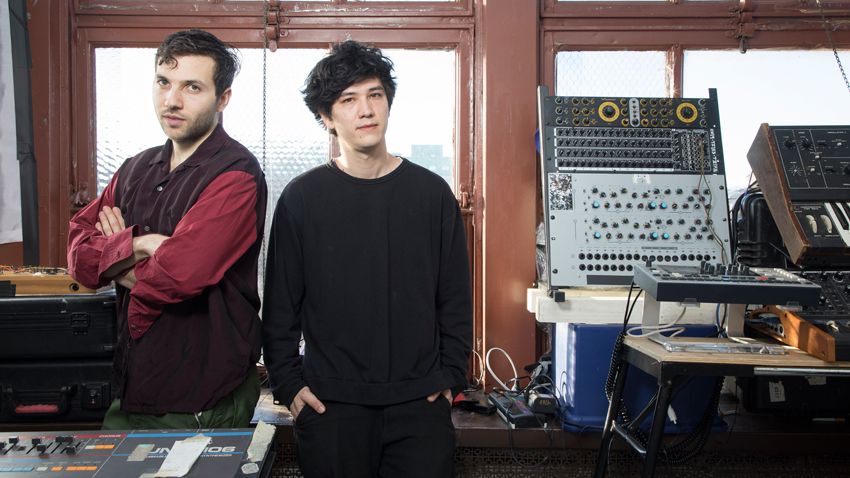
Nick Weiss and Logan Takahashi crossed paths while studying at Oberlin College in Ohio. Their shared interest in electronic music saw them immediately combine technologies, resulting in 2010’s leftfield electronic album 7AM, which spawned the underground club anthem Cheaters. They followed it up in 2012 with Tracer, on re-launched independent imprint R&S Records.
After a hectic period of creativity, the duo parted ways to focus on side projects, including Takahashi’s solo album Nogeo; but 2017 sees Teengirl Fantasy return in sparkling form with 8AM. Almost entirely instrumental, it’s their most introspective and abstract long player to date - pulsing with early house and disco themes, and perfumed by the duo’s evocative slow-motion-styled techno.
Did the two of you first get tuned into electronic music at a young age?
Nick: “Hip-hop and R&B was my main access as a (very) young producer. I interned at a hip-hop studio when I was about 11 - just observing mostly but sometimes running sessions. Eventually I got to submit a beat for one of their artists. It actually had a 4/4 dance vibe, even though I wasn’t fully aware of what I was doing.
“My primary influences back then were Missy & Timbaland, the Neptunes, Darkchild, Jimmy Jam and Terry Lewis. I started to learn more about house, techno and other electronic music in high school, and then got much deeper into it when I was in college.”
Logan: “My first memory of electronic music was playing on my dad’s Casio SMK-1 as a little kid and being spooked out and intrigued by its bell sounds. Later, I got into electronic music when I was at high school, originally via a bunch of weirdo outsider acts like Excepter and Black Dice. That stuff kind of led me to falling in love with techno and house towards the end of high school and into my college years.”
How did your love of those artists and genres segue into experiments with music technology?
Get the MusicRadar Newsletter
Want all the hottest music and gear news, reviews, deals, features and more, direct to your inbox? Sign up here.
Logan: “When I was 14, I got a copy of Ableton 4 for Christmas, and that was a turning point for me. I had grown up studying violin, but it wasn’t until that point that I was able to start viewing music as a way of expressing an identity or viewpoint. So I started a bunch of bands in high school with electronics being a major element. One of them was called Dipole Dipole, with my friend Guy. We’d basically experiment with tape samples and an array of guitar pedals.”
Nick: “I remember using Acid Pro on the computer - it was my very first introduction to music software. Then I moved on to Magix Music Maker. I wanted the Hip-Hop edition but the Trance one was the only one left at the store. They were both mostly loop-based programs; pretty similar to what GarageBand is now, but you could do really cool stuff in Magix, including making your own music video with green screen effects, which seems way more high-tech than what we have now.
“Later on, in high school, I got a Korg Triton LE keyboard with money I’d saved up from my Bar Mitzvah, because I knew it was what the Neptunes were using. It had an onboard sequencer, and I would make beats on that. I later sold it because I needed some fast cash, but I regret that now.”
You met each other in college - was there an immediate musical connection between you?
Nick: “We met at a new student orientation on pretty much the first day. We had some initial talks about music that excited us, mostly about some of the more DIY electronic acts that were bubbling up back in 2008. But our ‘sound’ just kind of came together intuitively when we started jamming on the instruments we’d brought with us to college.”
Logan: “I had a pretty good idea of the things that I was interested in and how I wanted to align myself in terms of the other music I was listening to when we started. At the time, there weren’t nearly as many people doing electronic house/techno-based music in the space that we were trying to do it in, so perhaps it was even easier back then to align and position ourselves in a certain way.”
So the first thing you did was to set about combing all your gear?
Nick: “Yeah, Logan had a Roland SP-404 sampling workstation, a microKorg and a Korg Electribe synth, and I had an Akai MPC and a Roland Juno-106. We basically made all our first songs using that gear.”
How did you get signed to Planet Mu?
Nick: “We’d met Mike Paradinas [aka µ-Ziq] at a show in London and heard through the grapevine that he was into our music. As a result of that, we held some initial conversations with him about releasing something and he, coincidentally, emailed us about releasing stuff on Planet Mu the same day we were about to send him our album demos.”
Logan: “It’s been great working with Mike and everyone at Planet Mu. It feels way different to receive comments about music from actual musicians like Mike and Jamie Kuedo that you already look up to, rather than A&R from a label or somebody who doesn’t actually release music themselves.”
Apart from some EP releases, there’s been quite a delay between this album and the previous one.
Nick: “That’s because we were both working on different projects at the same time as our own. I would say that life just got in the way, both living it and figuring out what we wanted to say after Tracer. That album was made pretty soon after we had just gotten out of college and I don’t think we really gave ourselves much time to think about what its overall concept would be. We just threw stuff up in the air, tried everything and released it. I think that 8AM has a lot more focus, and loads more tracks were made than actually ended up being on it. Planet Mu was also very helpful in paring down our ideas and editing the sequencing.”
Logan: “I guess we’d been kind of slowly but steadily working on a collection of new tracks since 2013 and probably worked in seven studios across the UK, the US and Germany. We also devoted some time and energy to other projects, including doing an original score last year for [Vogue’s] Opening Ceremony Fall/Winter 2016 soundtrack. We also released some EPs and remixes, and did some other solo and collaborative projects. I released a solo Logan Takahashi album - Nogeo - on Ghostly last year, that I’d wanted to get out for a while.”
You could say you’ve come back refreshed. Do you think the break has changed your sound?
Logan: “The main difference between Tracer and 8AM has been the lack of vocal collaborations. We only have one track on the album with vocals, which is the track we did with Khalif Diouf [also known as Le1f]. This is also the first time we ever really tried going into the studio with a specific concept or idea in mind: the melancholic dancefloor glowy comedown or ‘after-peak’ vibe. We were jokingly calling the album 8AM years before we officially decided to make that its name.”
Have you substantially upgraded your studio or modified how you work between this album and the last?
Nick: “We didn’t really have a studio for our previous albums - we worked in bedrooms, living rooms and friends’ studios. For this album, some of it was recorded in a cabin in upstate New York, and then as we were finishing it we started using our current studio space. The previous two albums were also made on Logic Pro, whereas this album was fully written on Ableton. That allowed much more freedom in terms of how it was edited. Our previous records were more like live jams with some editing into tracks, whereas with 8AM, some songs might have elements of a live jam but we did much more writing and arranging in the computer afterwards.”
Our previous records were more like live jams with some editing into tracks, whereas with 8AM, some songs might have elements of a live jam but we did much more writing and arranging in the computer afterwards.
You mentioned using Ableton, but I understand that you used to work on Logic. Why the switch?
Nick: “Logan’s primarily using Ableton. Logic lost me when they updated to X. I was a veteran Logic user ever since it was Emagic, but then it was upgraded and the people who owned it were just expected to buy it again. I still think Logic Pro 9 sounds really great, but you just can’t beat the ease of use and speed with which you can write in Ableton. My ultimate wish would be for Ableton to make its audio engine sound as good as Logic 9’s.”
So what’s in your virtual production armoury of soft synths ?
Logan: “The main soft synth we use is Omnisphere, but we don’t use soft synths much as we don’t like it when you can ‘hear the computer’ through the music. But Omnisphere is obviously a really deep instrument. Because it’s based on real-world sounds, it really does sound powerful when matched up against hardware.
“Having said that, Rob Papen’s SubBoomBass is a pretty good soft synth, and The Granulator 2 Max For Live instrument in Ableton is super fun to play around with and great for generating ideas fast.”
What about effects? What are the trustiest plugins in your folder?
Logan: “We have a bunch of effects plugins, and we tend to use them in a kind of grab-bag way, just quickly putting one in while we’re working, and if it works it stays. I recently signed up for the subscription service at Slate Digital because their Virtual Mix Rack is pretty great for basic mixing EQs and compressors. They have some pretty solid presets to start from, and while the plugins have a subtle sound, they do make a difference.”
Nick: “We use the Slim Slow Slider VST plugin when the basic Ableton sidechain compressors aren’t enough. It does much more drastic sidechain compression for when we want the ‘pump’ to be audible instead of just using it as a mixing tool. We also like to use PSP’s MixPack; those plugs are pretty solid for saturating a signal when the stock Ableton Saturator - which I actually think is one of Ableton’s most amazing plugins - won’t do. We’ll use them to add midrange to a bass or make certain signals more audible when the mix is cluttered.”
Logan: “iZotope Trash has been one of my go-to plugins for the last year or two. It suddenly turns sounds that you wouldn’t consider using in a mix into palatable sounds. It can be quite a heavy-handed effect, but I’ll use it more subtly, sometimes only using 10% or less of the wet - like a little dash of spice in a dish!”
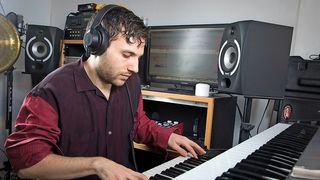
But you also like to use plenty of outboard, right?
Logan: “Yes, we use an Ensoniq DP/4 effects rack, although it actually belongs to our friend James Connolly, aka L-VIS 1990. While he’s been out of the States, it’s been living in our studio and has ended up being a great companion for this album. We run just about everything through it, because it helps to achieve a more ‘real’ sound – whatever that means. What we also like about it is that whatever we run through it as an effect cannot be messed with later like you could an effects plugin. Because it’s set in stone, you have to like whatever the effect is - I especially like the harmoniser and guitar distortions on this rack. We also like the Eventide Eclipse for its rich reverb, and we’ve been using that for quite a while.”
Do you have any tips or techniques on sound design and creation?
Nick: “Creative panning can be super-effective. Being able to draw the pan in Ableton or have certain high-frequency elements on a pan with LFO can be a good way to create dimension. Stereoisers are cool, but they often weaken sounds.”
Logan: “We’ve got into the habit of always trying to record a live take of an automation first, preferably with a real knob or controller. You can hear the live-ness of it better that way, and of course you can always adjust it later.
“Just think with your gut and trust your intuition, and louder isn’t always better. Increasing our dynamic range was something we talked about a lot with some of these tracks.”
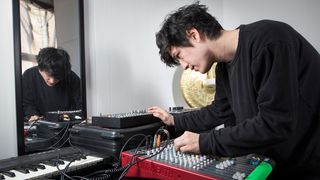
Are there certain tenets you stick to when it comes to trying to achieving a great mix?
Logan: “When we’re making a track, there usually comes a point where the focus becomes more about what things to take away rather than what to add. Simplifying and subtracting has become a crucial step in the process for us.”
Nick: “Honestly, I think learning the ‘proper’ way to mix has been a double-edged sword. Yes, your mixes might become cleaner and more high-definition, but it’s easy to go overboard and stop just listening. I’m really trying to detox from the habit I got into of staring at plugins while mixing, and just trying to listen as carefully as possible. I think having that balance of intuition and learned skills is the best.”
What tools do you use for compressing and limiting the sounds within your mixes?
Nick: “I’m still trying to figure this out, but usually I’ll mix into a limiter with the threshold at zero, just to catch the peaks. My advice would be to make the attack slower if you want louder transients. I try to match the makeup gain to a little below the amount of gain reduction, so that the volume isn’t lost from compression - just the little peaks.
“The stock Ableton Glue compressor is pretty good, actually, and the Waves CLA-2A is also good for when things need to be loud. Slate Digital compressors are pretty good for a more transparent style. Using sources other than just a kick for sidechaining can help you find some nice unexpected grooves.”
What are the different strengths behind the various hardware synths in your studio?
Logan: “We have the Elektron Monomachine, which is great for sequencing, both onboard and MIDI out. It’s also great for bass and off-the-grid rhythmic sounds. I’ve got into exploring the different user waveform packs that are out there, too, so it’s still a valuable piece of gear in our setup six years in.
“Our newest piece of gear is the Elektron Analog Rytm, which appears on a few tracks on the album. We’re really into this one - the analogue synths cuts through in the mix in a really nice way, and the drum sounds are nice and full. It’s probably the most intuitive piece of Elektron gear they’ve released so far.”
You have a few classic synths like the Roland V-Synth and, as you mentioned previously, the Juno-106…
Nick: “We discovered the Roland V-Synth because it was sitting in a writing studio we used in the UK. It’s a truly bizarre workstation from 2003 that kind of does everything at once, while doing nothing a digital workstation would normally do. For example, there’s no true piano or string sound, but there are a lot of digital monks and indescribably elastic-sounding arpeggiators. It has a rough, plasticky quality that we utilised a lot on this album. The sounds can be controlled with a digital beam handwaving motion, so it produces organic modulations of inorganic compound sounds.
“The Juno-106 has been our go-to synth for chords right from the beginning. It makes some appearances on 8AM because we love to use it with the chorus effect on, but we recorded in mono.
“We also use a Korg Wavestation SR, which is a sick rackmount digital wavetable synth. We downloaded some patches from some random corner of the internet and loaded them via SysEx. The Wavestation has a good ethereal, mountainous vibe.”
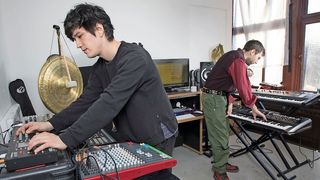
Where do you stand on the modular craze? Is it something you’ve looked into?
Nick: “Modular synths always look really cool and impressive, but they sometimes seem limited to me in terms of what sounds you can actually get out of them beyond bleeps and squiggly res-y bloop sounds. But I can’t really say, as I’ve never gone in-depth and used one.”
Logan: “I respect the amount of control they give you over the sounds, and I appreciate the idea of people building their own sounds rather than selecting presets. Sometimes it feels like a scene unto itself, but you could also say the same thing about making music on computers. Basically, if I had more money I probably would have got more into it by now.”
Do you like to accumulate a variety of kit, or do you prefer to go deeper into a few select pieces?
Nick: “More gear is not the answer to making better music. Knowing the gear you have super-well is much more important. That being said, walking into a studio filled with random toys you’ve never seen before can be inspiring and help to make a new track fast. One of the tracks on our album, Star-rise, was made in a studio in Berlin that was filled with sick synths and a Japanese board that made everything sound really thick when you ran stuff through it. But that studio was all arranged for everything to only be recorded as a two-track, which I thought was crazy!”
Many of our earlier songs were composed live, so they’re a little easier to play out, but with the addition of Logan’s Elektron Octatrack, we’re able to sample stuff out of the computer but still be super-flexible with it.
Do you master your own records, or do you prefer to hand that part of the process over to somebody else?
Nick: “8AM is our first record to be mastered by Beau Thomas at Ten Eight Seven Mastering in London, otherwise it’s mostly been done by Joe LaPorta. We went with Beau for the Planet Mu record because he masters all of their releases and we didn’t want to break form with them. We’ll definitely still be mastering with Joe in the future - they’re both fantastic.
“Since we didn’t have any help with mixing 8AM, the mastering was more important in order to help the tracks sound more slick and complete. We often prefer more muted sounds, which can end up with purposefully muddy or dark mixes, so I think mastering helps to balance that out.”
How do you spin a studio project into something you can use to play live?
Logan: “My setup is mostly Elektron-based at this point. The memory structuring on their machines can seem a bit convoluted, which is why I don’t think people use some of their machines to their full capability. This was my problem at first, but there’s so much room and space on these things to invite endless non-destructive variations and playing with ideas. The ability to end up in a new place from where you started is what I appreciate, and it’s what I try to cultivate in a live setup.
“Basically, we have all our gear synced to a MIDI clock, triggered either by the MPC or the Monomachine. When recording, we’ll send MIDI clock out from Ableton, connected to all our gear so that they can start on time.”
Nick: “When we first started touring, the gear we made the music with was exactly the same gear we brought out to play. But now I’ve been able to replace my Juno-106 on tour with the new JU-06, which is a portable digital version. Man, I really wish this existed a few years ago when I was slowly destroying my Juno-106, lugging it around the world.
“When we improvise at shows, it’s pretty similar to the improvisation process when we write a song. Many of our earlier songs were composed live, so they’re a little easier to play out, but with the addition of Logan’s Elektron Octatrack, we’re able to sample stuff out of the computer but still be super-flexible with it.
“Now, we’ll often rewrite or create new songs when we’re performing live. I also like to project to the audience the fact that we’re playing live rather than DJing - sometimes people make this mistake even when we have keyboards on stage!”
Teengirl Fantasy’s latest album 8AM is out now on Planet Mu.


Computer Music magazine is the world’s best selling publication dedicated solely to making great music with your Mac or PC computer. Each issue it brings its lucky readers the best in cutting-edge tutorials, need-to-know, expert software reviews and even all the tools you actually need to make great music today, courtesy of our legendary CM Plugin Suite.


